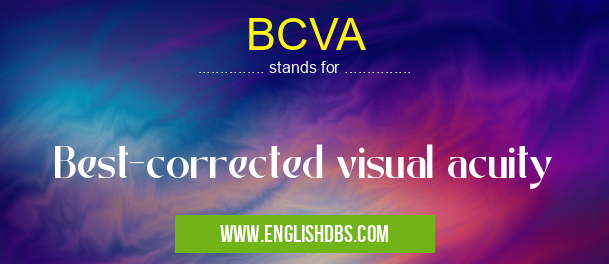What does BCVA mean in NURSING
Best-corrected visual acuity, commonly abbreviated BCVA, is a measure of how well a person can see after their vision has been corrected with devices such as glasses or contact lenses. This test is typically carried out by an eye care professional using standardized charts to determine the best possible visual outcome for each patient. The result is expressed in terms of a fraction or letter score that indicates the level of clarity with which a person can see at a particular distance.

BCVA meaning in Nursing in Medical
BCVA mostly used in an acronym Nursing in Category Medical that means Best-corrected visual acuity
Shorthand: BCVA,
Full Form: Best-corrected visual acuity
For more information of "Best-corrected visual acuity", see the section below.
Definition
BCVA stands for Best-Corrected Visual Acuity and is used to measure someone's best possible visual acuity (sharpness of vision) following correction with eyeglasses or contact lenses. It's measured by presenting standardized charts at a set distance and recording the person's ability to distinguish letters or symbols on them. Results are expressed as fractions like 20/20 or 20/40, indicating the number of letters seen correctly over the total presented at that given distance.
Process
The BCVA evaluation process begins when an eye care professional evaluates your eyesight without any corrective devices, such as glasses or contact lenses. Afterward, they will then fit you with corrective devices to obtain your best possible visual outcome. They will then present standardized charts at various distances and ask you to read them out loud so they can record your results. Based on how many letters you were able to correctly identify, they can calculate what your BCVA score would be from those results — either expressed as a fraction or letter score.
Essential Questions and Answers on Best-corrected visual acuity in "MEDICAL»NURSING"
What does BCVA stand for?
BCVA stands for Best-corrected visual acuity. It is a measure of how well a person can see when wearing corrective lenses such as glasses or contacts.
How is BCVA measured?
BCVA is measured by having a person read a standardized eye chart while wearing their corrective lenses. This measurement helps to pinpoint any vision issues and allow the optometrist or ophthalmologist to better assess the patient's overall visual health.
Is BCVA important for children with vision problems?
Yes, measuring a child's best-corrected visual acuity is important to help diagnose any vision problems and determine the proper corrective lenses they may need. It can also help monitor any changes in their vision over time.
Are there different kinds of eye charts used to measure BCVA?
Yes, there are several different types of eye charts used to measure best-corrected visual acuity. Some of these include the Snellen chart, Sloan letter chart, Landolt C ring chart and Tumbling E chart.
How often should I get my BCVA tested?
Generally, it is recommended that people have their BEST-corrected visual acuity checked at least once every one or two years depending on their age and risk factors for developing vision issues due to medical conditions or lifestyle habits. To be sure, you should always ask your doctor what frequency would be best for you.
What happens if my BCVA test results come back lower than normal?
If your BEST-corrected visual acuity test results come back lower than normal, your doctor may recommend additional tests as well as lifestyle and/or medical treatments in order to improve your eyesight and keep it stable over time.
Can glasses affect my BCVA score?
Yes, glasses can definitely impact your BEST-corrected Visual Acuity score since they are used during the testing process itself. Be sure you wear only the glasses prescribed by your doctor in order ensure the most accurate results possible when taking this type of exam.
Are there certain activities that can preserve my BCVA performance? A: Regularly performing activities that promote good vision health can help maintain and even improve your BEST-corrected Visual Acuity score over time. Such activities include avoiding extended exposure to blue light from screens like computers and smartphones, eating nutritious foods with vitamins A & C, getting enough restful sleep each night and taking regular breaks when engaging in close work like reading or using digital devices at close range for long periods of time.[END] Q: Is it possible to have an excellent ACU but still struggle with vision problems? A: Yes, it is possible to have an excellent BEST-Corrected Visual Acuity score but still experience difficulty seeing clearly due to other factors such as dry eye syndrome, astigmatism or other underlying conditions that compromise overall vision quality even when wearing corrective lenses.[END] Q: Are there certain behaviors that could lead to poorer vision health over time?
Regularly performing activities that promote good vision health can help maintain and even improve your BEST-corrected Visual Acuity score over time. Such activities include avoiding extended exposure to blue light from screens like computers and smartphones, eating nutritious foods with vitamins A & C, getting enough restful sleep each night and taking regular breaks when engaging in close work like reading or using digital devices at close range for long periods of time.
Final Words:
BCVA is an important metric when it comes to assessing someone's vision because it provides an accurate picture of how well their sight has been corrected after external intervention - usually occurring in the form of eyeglasses or contact lenses. As such, this metric helps eye care professionals monitor progress made in treating patients' eye problems and determine whether further treatment may be necessary.
BCVA also stands for: |
|
| All stands for BCVA |
